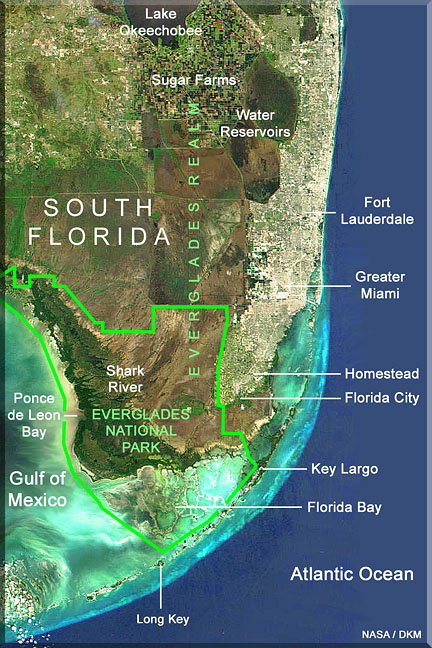ORIENTATION INSIDE THE PARK
Duane K. McCullough

Overview Map of Southern Florida
As we look at the overview map of southern Florida we will notice that we are just within the boundary of Everglades National Park near the bayside of Key Largo. The mainland of Florida is about ten nautical miles north of us and the Gulf of Mexico is about thirty nautical miles to our west. Everglades National Park was established over a half a century ago and covers much of the southwestern tip of Florida where freshwater plants and animals exist -- but a large realm within the park also includes Florida Bay where many saltwater plants and animals can be found.
If you haven't already visited the main visitor center of Everglades National Park just west of Florida City on the mainland north of here, I would highly recommend you do so. There, and at the Royal Palm visitor center also near the main gate of the park, can be found viewing opportunities of alligators and many other freshwater plants and animals that inhabit the park.
The seawater within this portion of Florida Bay is saltier than the seawater of the Atlantic Ocean or the Gulf of Mexico because gulf seawater floods into the bay and evaporates overtime. Every time this evaporation process takes place, the seawater is concentrated with marine sea salts like sodium chloride -- also known as "table salt".
Other marine sea salts like magnesium sulfate or "Epsom salts" are also found within the seawater and have interesting medicinal and nutritional qualities. More will be said later in the tour about the healing properties of these marine salts and other unique mineral elements found in the area.
The upper Florida Bay area where we are does not experience the normal two or three foot lunar tidal movement like the Oceanside areas of the Florida Keys because the bay here is so shallow and the distance to the Gulf of Mexico so far away, the lunar tide can not rise and reach this far in the upper bay area in time before it has to fall again.
But the water level does move up and down a foot or two several times a year because of wind tides. Strong winds from the east will blow the water out of the bay toward the Gulf of Mexico and lower the water level -- or strong winds from the west will blow water in from the Gulf of Mexico and raise the water level in this portion of the bay.
As mentioned before, the average depth in this area of Florida Bay is only about three or four feet -- but some mangrove creeks are about eight feet in depth. There also exist many sand and sea grass banks that stretch across the bay that restrict tidal flow from the Gulf of Mexico.
Local captains have a local saying to help them remember to avoid the very shallow sea grass areas and is based on the color depth of very shallow water. The saying goes as -- "green, green, nice and clean" while "brown, brown, run aground" helps a boat operator to safely navigate Florida Bay.
Unfortunately, many visiting boat operators -- and even some local boat operators, do not know or care about the marine life that exist within the "brown" areas and run aground with their boats. When a boat runs aground, the motor prop -- like a small metal tornado, destroys everything in its path and can leave very long scars in the sea grass meadows that can last over ten years to heal. Look down to our right -- you can see several prop scars as long white line areas in the sea grass.
If these people that tear through the sea grass meadows of Florida Bay with their high speed boat motors could see and realize the damage they cause they would be more careful and choose a safer way to operate their boats. Because power boats displace less water when traveling faster than traveling slower, the boat operator gambles with the odds of not running aground over shallow waters by choosing speed over safety. But overtime, when they lose, we all lose a very important link in the natural resources of the bay.
Although park rangers do catch some boat groundings and issue fines to the operators, many groundings are not reported because Florida Bay is such a vast area, park ranger police can not be everyplace when it happens.
Being aware of the small things out here in the bay is just as important as experiencing the larger things we all come to see. About halfway through out tour, I will use a small fishnet to catch and reveal in a small aquarium many small animals that live and make their homes within the sea grasses.
<< Previous Page THE DEPARTURE <|> Next Page MARINE TREES OF THE BAY >>
Return to the Islands of the Bay Coverpage
Return to the Lost Fountain website

